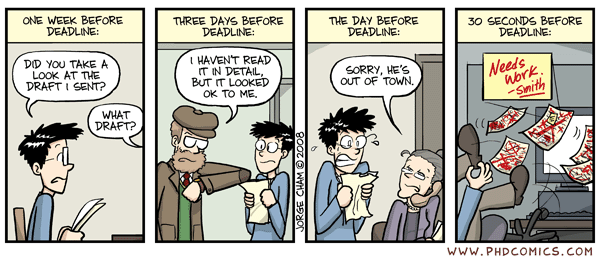As a first-year grad student, I was so excited to start my thesis work. I brainstormed to make a list of experiments to try and then discussed them with one of the senior grad students in the lab. As I enthusiastically explained the goals of my experiments and what I was planning, he gave me a strange look. Puzzled, I asked for some feedback. He told me that, while these were good research ideas, almost all of them had been published. Hence, my first lesson learned from grad school: immerse yourself in the field by reading relevant papers and then plan some innovative experiments to move forward. It’s critical to have a deep knowledge of your field of study—not just to be a good grad student, but to see what is being done and then build on it, or take a totally different approach to innovate.
Reading papers is a big part of keeping up with the latest research. And attending conferences can give you a sense of current work before it’s published. However, I’m sure that, at least once, you’ve heard a cool talk at a conference and then quite a while later, haven’t seen the corresponding paper (so that you can read about all the ins and outs of what they did!). Why would this be? They may have been discussing the data early on in their project. Or perhaps they submitted a manuscript and the review/publishing process is taking a long time. Maybe the data were so surprising that they felt they needed to do a lot of follow-up work to support their conclusions. Or maybe their PI takes forever to write/comment on manuscripts. Etc.
The sooner that you can find out what is going on in a field, the sooner you can design smart, relevant experiments. What can be done to get cutting edge work out there to facilitate the progression of a field as a whole?
Bottlenecks in communicating research can occur at 5 different points in the process. Here are some tips to try to alleviate these delays.
- Time to generate the increasing amount of data needed to deem a project ready for publication. Over the last several decades, the number of figures in life sciences papers has increased1,2, suggesting that more data are required for publication. There is also a push to publish in journals with the highest possible impact, which may require more data to substantiate acceptance.
Tips to help: It’s difficult to make experiments go faster; however, you can plan ahead to do your experiments as efficiently as possible. Also, map out what your paper will look like and determine if there are additional experiments needed. Clarify the main story of the data that you want to present, and make sure that you have designed well-controlled experiments that test your hypothesis. Another planning tip: make a list of experiments that could address comments that you anticipate from reviewers. Then, you can be ready to perform any requested experiments when you get the reviews back.
- Delays in writing and editing prior to submission. Writing takes time—time away from the bench, which may not be desirable for a scientist. Also, PIs are often tasked with many other responsibilities which could slow their ability to provide manuscript comments. This might happen more frequently in large labs or in labs with established PIs whose career is not as affected by publication frequency.
Tips to help: Communicating about your work is important, so make it a priority. Schedule time into your day for writing and stick to it. If you really can’t focus, then consider putting some experiments on hold.
While it is difficult when you have a PI who is not available, there are things that you can do to facilitate the submission process. For example, familiarize yourself with the requirements for the journal that you will submit to and ensure that the manuscript is properly assembled and formatted. That way, when your PI is ready to give feedback, you already have those time-consuming tasks completed.

http://phdcomics.com/comics/archive.php?comicid=1001
- Seemingly long review process. Many journals are inundated with manuscript submissions, which may result in a longer time to screen through research appropriate for the journal. Also, the review process can be lengthened by reviewers that are overloaded with other responsibilities3.
Tips to help: Preprints—manuscripts and corresponding data posted before peer review—are becoming more accepted in the life sciences and with many journals and funding agencies4. Online preprint archives, such as Cold Spring Harbor’s bioRxiv, allow researchers to post a manuscript that is then available in just a few hours for anyone to access, share and add comments.
Choose wisely when deciding where to submit the paper. Look at the content currently published by the journal and assess if it’s a good fit. Selecting the appropriate journal may help to expedite the process.
- Inadequate articulation of experimental methods. Problems with reproducibility are a major issue in science that can hinder progress. This is made worse when methods are minimally described in journal articles or refer to previous articles that give similarly little insight into the details of the method used.
Tips to help: Some journals allow unlimited text length for the methods section, which is provided as an online supplement. Open online repositories to post step-by-step protocols, such as protocols.io or Protocol Exchange (Nature journals), are even more helpful. About 200 journals instruct authors to post protocols on protocols.io5, which allows users to ask authors questions about protocols and post modifications to the protocol that reference the original protocol.
- Lack of “marketing” to disseminate results. Scientists put so much work into their research and the publication process and then hope that someone will read their work. Or they must wait to show the work at a conference which may or may not fit in with the timing of the project.
Tips to help: Twitter and other social media outlets are ways that scientists can find out what research is going on. Create your own posts, or even talk to your institution’s Public Relations department for advice or to see how they can help you to spread the news.
Until there’s a more consistent way for researchers to market their papers, you need to be proactive in finding out what’s current. For example, you can use Twitter to follow people or groups that tweet about a certain field. Another option is to set up a daily keyword search with PubMed or Google Scholar. That way, you’ll get new papers sent directly to your inbox.
Another component of communication somewhat outside this list, but equally (if not more) important is communication of science to non-scientists. Practice explaining what you are doing and why it is important in 30 seconds or less. Use analogies and relatable examples to engage the person you’re talking with. In many cases, research is funded by government agencies via tax payer money, so it’s crucial for the public to know how important it is to support science!
1 Vale, RD. 2015. Accelerating Scientific Publication in Biology. PNAS 112: 13439–13446. DOI: 10.1073/pnas.1511912112
2 Cordero, RJB et al. 2016. Life Science’s Average Publishable Unit (APU) Has Increased over the Past Two Decades. PLoS ONE 11(6): e0156983. DOI: 10.1371/journal.pone.0156983
3 It Takes Time. 2008. Nat. Struct. Mol. Biol 15: 889. DOI: 10.1038/nsmb0908-889
4 Kaiser, J. 2017. Are Preprints the Future of Biology? A Survival Guide for Scientists. Science. DOI: 10.1126/science.aaq0747
5 Teytelman, L. 2018. No more excuses for non-reproducible methods. Nature 560, 411. DOI: 10.1038/d41586-018-06008-w

